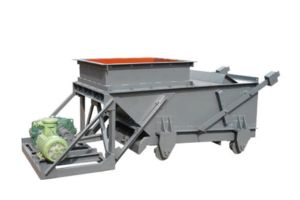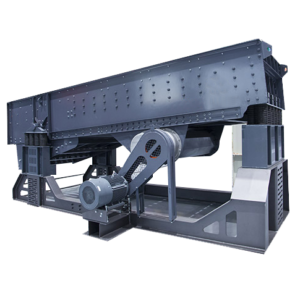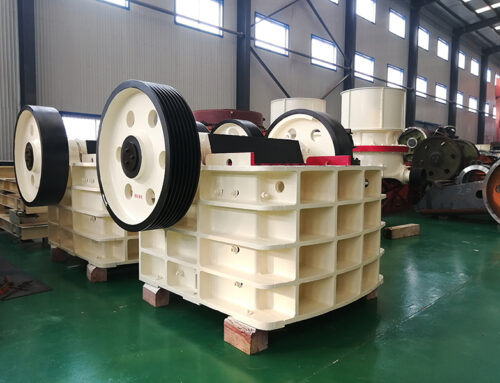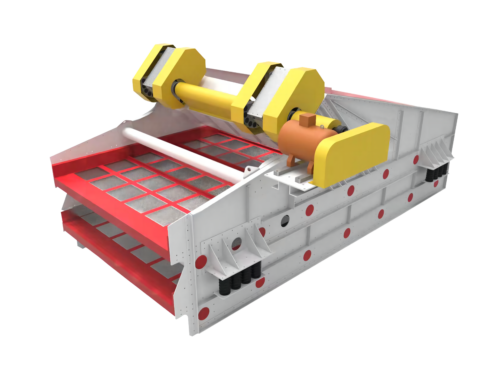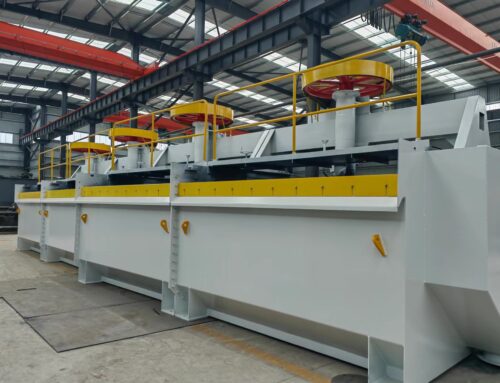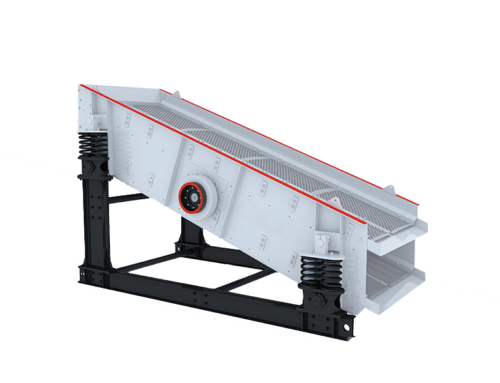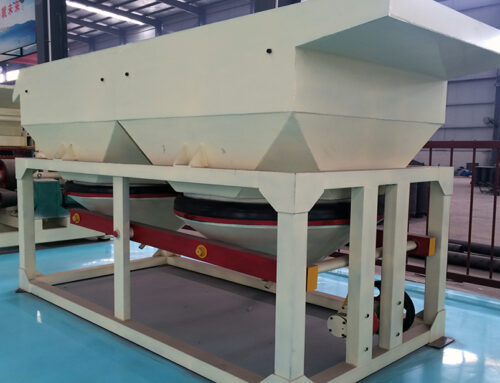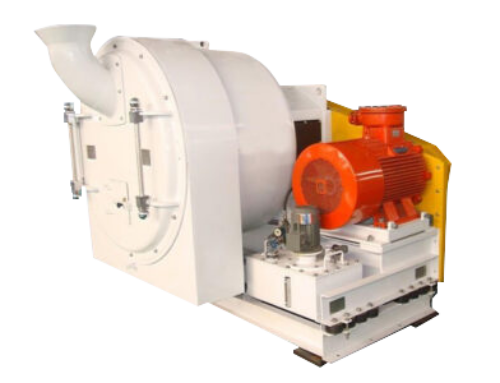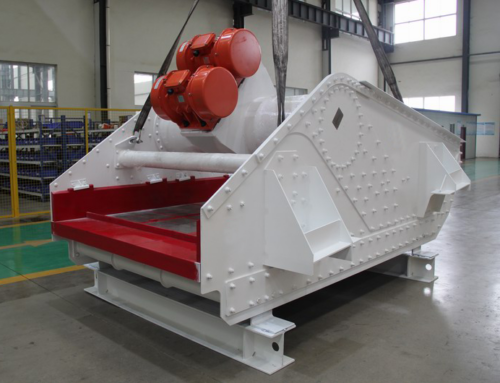一.Lg type chain feeder
As an ideal feeding equipment for jigger, LG type chain feeder has many remarkable features. It is widely used in coal, cement, metallurgy and chemical industry, etc. It is mainly used for conveying mixed loose materials with particle size between 0 – 100 mm.
Firstly, LG type chain feeder can feed materials evenly along the full width of the jigger, and this feature makes it especially suitable for large and medium-sized jigger. In practical application, it can be fed into the jigger uniformly and equally along the width of the jigging chamber according to the processing capacity set by the jigger, which effectively avoids the defect that the jigger cannot get uniform feeding.
Secondly, the feeder adopts frequency conversion speed control technology, which can infinitely adjust the feeding volume and realise automatic feeding. This function enables the operator to easily adjust the feeding speed according to the actual production demand and improve the production efficiency. At the same time, LG type chain feeder can also pre-wet the raw coal to prevent the occurrence of the phenomenon of agglomeration, which further improves the sorting effect of the jigger.
二.Reciprocating feeder
Reciprocating feeder has many significant advantages. Firstly, the feeding capacity is large, which can meet the demand of large-scale production. Secondly, the feeding size is large, generally used in the raw material warehouse, particle size up to 2m, can deal with larger particles of materials. Furthermore, it can withstand a large pressure bin and certain impact of large materials, and adapt to complex working conditions. In addition, it can transport hot materials, even can transport 500 – 1000 ℃ baking lump ore, has a strong heat resistance. It can also be arranged in an inclined position, in particular, it can be transported in an inclined upward direction of 25°, so that it can be adapted to a variety of complex processes. Moreover, the noise is small and will not produce too much noise pollution.
This series of feeder can fully meet the modern large-scale high-yield and high-efficiency mine system and other occasions on the large flow conveying system feeding requirements. It uses crank linkage mechanism to drag the 5° downward tilted bottom plate to do linear reciprocating motion on the roller, so as to unload the coal or other loose granular and powdery materials with small abrasiveness and low viscosity evenly from the feeding equipment to the receiving equipment.
Reciprocating feeder is suitable for mining, mine, coal plant, station, coal transmission workshop, port bulk dock and other bulk material transfer, bulk material through the silo or directly for uniform reproduced to the belt conveyor or other screening equipment, storage devices, etc. with the use of. Achieve the uniform feeding of ore, sand coal, grain and other bulk materials.
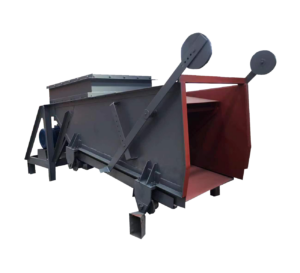
三.Mining Feeder
Various types: Mining feeders are available in a variety of types including belt feeders, vibratory feeders, auger feeders and scraper feeders, each designed to meet different material and process requirements.
Durability: These machines are designed to be extremely durable as they are often used in harsh mining environments, handling hard materials and heavy duty use.
Adjustability: Mining feeders typically have adjustable settings to fine-tune the rate and amount of material delivered according to processing needs.
Load capacity: These feeders must be able to handle large quantities of ore and minerals, making them robust and able to carry large loads.
Flow Control: Mining feeders are often equipped with flow control devices to ensure that material enters the downstream equipment at the proper rate to maintain smooth operation.
Main areas of application:
Mining: Mining feeders transport raw ore from the mining site to crushing, screening and beneficiation equipment to extract valuable minerals.
Ore Processing: In ore processing facilities, these feeders transport ore from storage bins or yards to processing lines.
Coal Mining: In coal mines, feeders transport raw coal to coal washing equipment, crushing equipment and coal mining machinery.
Metal Smelting: In metal smelting, mining feeders transport metal ores to smelters or metallurgical equipment.
Mining Equipment: These feeders are also used to transport components to mining equipment and heavy machinery.
Mining feeders play a vital role in the mining and mineral extraction industry by ensuring efficient conveying and continuous supply of ores and minerals, thus helping to increase productivity and reduce production costs. They are often specially designed to withstand the harsh conditions of the mining environment and ensure the smooth handling of materials during mining and ore processing operation
四.Heavy Vibration Feeder Machine
Heavy vibration feeder machine is mainly used in the fields of coal mine beneficiation and washing, lime processing, ore handling, dock loading and unloading, aggregate, glass, cement, wood products and steel industry.
Heavy vibration feeder machine has the characteristics of high productivity, strong environmental adaptation, high bearing capacity, vibration and noise reduction, long service life, etc., and plays an important role in various fields, providing efficient and stable material conveying solutions for the production process. In coal mine washing, it can accurately transport coal to the next step and improve the efficiency of washing; in lime processing, it can ensure the uniform supply of materials and ensure the quality of production; in ore processing, it can adapt to different particle sizes of ore to achieve high efficiency of feeding; in wharf loading and unloading, it can complete the transshipment of materials in a fast and stable manner; in the fields of aggregates, glass, cement, timber products and the iron and steel industry, it also plays an indispensable role. In the fields of aggregate, glass, cement, wood products and iron and steel industry, it also plays an indispensable role.
五.The four big feeder how to choose
When selecting a feeder, a number of factors need to be considered to ensure that you select the best equipment for a particular application scenario. Here are some considerations for selecting one of the four major feeders:
1.Selection according to application scenario
For large-scale jigger, priority can be given to Lg type chain feeder. It can feed the material evenly along the full width of the jigger, which is especially suitable for large and medium-sized jigger to improve the washing effect of the jigger.
For the scene that requires large feeding capacity and can withstand the impact of large materials, reciprocating feeder or heavy vibrating feeder can be chosen. Reciprocating feeder has large feeding capacity and can meet the demand of large-scale production. Can deal with particle size up to 2m of material, can withstand a lot of pressure warehouse and withstand a certain impact of large pieces of material, but also can transport hot materials and even up to 500 – 1000 ℃ baked lump ore, can be arranged in an oblique position, low noise.
Heavy-duty vibrating feeder is mainly used in coal mine washing, lime processing, ore processing, dock loading and unloading, aggregates, glass, cement, wood products and iron and steel industry and other fields. They are characterised by high productivity, strong environmental adaptation, high load carrying capacity, vibration and noise isolation, and long service life.
For different mining operations, according to the nature of materials, site conditions, etc. to choose the right type of mining feeder.
Heavy plate feeder can be adjusted according to the speed of the chain plate, strong impact resistance, large ore feeding capacity, long service life, mainly used for large mines, coarse broken ore feeding. Light plate feeder is mostly used for rough breaking feeding in small and medium-sized mines.
Belt feeder to adapt to the large feeding volume of work, the application of a wide range of scenarios, is efficient, fast, smooth and vibration-free feeding equipment. For example, the belt feeder produced by Henan Shenggong Heavy Mining Machinery & Equipment Co., Ltd. has the features of small operating power, light weight, large feeding capacity, stable feeding capacity, convenient adjustment, low noise, small maintenance, and strong generality of parts.
2.Consider the material characteristics
If the material is sticky, for LG type chain feeder, it is necessary to pay attention to the prevention of material balling phenomenon, and it can make use of its function of pre-wetting the raw coal. For reciprocating feeder, the chain speed should not be too fast, so as not to cause material accumulation and clogging; if the material is viscous but the moisture content is very low, ordinary mining plate feeder can be. For heavy vibrating feeder, according to the viscosity and humidity of the material and other characteristics, choose the appropriate model to ensure smooth and stable feeding.
If the material particle size is large, reciprocating feeder and heavy vibrating feeder can deal with larger particles of material, which reciprocating feeder is generally used in the raw material silo, the particle size of up to 2m; Heavy vibrating feeder can be used in the field of ore processing, adapting to different particle size of the ore. For mining feeder, heavy plate feeder impact resistance, suitable for processing large particle size materials, while light plate feeder is suitable for small and medium-sized mines coarse crushing feed, processing relatively small particle size materials.
3.Consider the production requirements
Feeding capacity requirements: if the production needs a large feeding capacity, reciprocating feeder feeding capacity, foreign countries have reached 12000t / h, the domestic has reached 5000t / h; heavy vibrating feeder also has a high capacity for mining feeder, different types of feeder feeding capacity is also different, such as heavy-duty plate feeder feeding ore, suitable for large-scale mines coarse crushing ore; belt feeder to adapt to the large amount of feed The belt feeder is suitable for large feeding capacity.
Feeding stability requirements: if you need stable feeding, for LG-type chain feeder, the use of frequency conversion speed control technology can be infinitely adjustable feeding volume, but the maintenance is relatively large. Reciprocating feeder feeding discontinuous, low productivity. Pendulum feeder in the mining feeder to feed a stable amount of ore, but the adjustment of the amount of feed trouble; heavy vibrating feeder to a certain extent can provide a more stable feeding.
In summary, the selection of the four major feeders need to take into account the application scenarios, material characteristics, production requirements, equipment costs and other factors, in order to achieve efficient and stable feeding operations.

